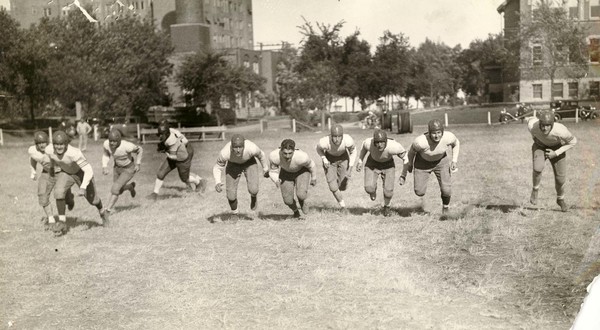1880-1895
Two students in the graduating class in 1881 who became well-known later in life were Thomas B. Finn and Carter H. Harrison, Jr. Finn became a Jesuit and a noted educator. Harrison went on to Yale University for his LL.B. then returned to Chicago where he served as mayor from 1897 to 1905 and from 1911 to 1913.
Many years later in his autobiography, "Stormy Years," Harrison paid this tribute to his alma mater, "I liked the friendly attitude and surroundings at Loyola where the boys came from the plain classes. I liked Loyola, I had the conviction the training was good for me."
An eight-page publication called Easter Chimes came into being in 1888; the publication did not last long but it was the forerunner of a college magazine that would eventually be known as the Loyola Quarterly. A scientific academy and camera club were formed in 1892, and football came into its own at Loyola that same year.
At the same time, Chicago was growing as a city; it was the site of the famed Columbian Exposition in 1893. When the Exposition was at its height, the financial panic of '93 swept the country.
But Chicago kept progressing along with the university. It was during this period that an elevated railroad, the Lake Street "L" was completed and the West Side "L" was begun.
Higher education was taking root in Chicago. The Armour Institute of Technolgoy, now Illinois Institute of Technology, opened its doors in 1893, and the University of Illinois and Northwestern University established professional schools in the city.
The Benedictine Fathers founded St. Procopius College in Chicago where the school remained from 1887 until 1901 when it moved to its present campus at Lisle, Illinois.
St. Stanislaus College, launched in 1890, was under the direction of the Polish Fathers of the Congregation of the Resurrection.
The well-known Newberry Library moved to larger quarters at Walton Place in 1893, and the famous John Crerar Science Library was founded in 1894 for the advancement of scientific research and knowledge.
But it was not always an easy road for the college nor the Jesuits who ran it during this era. There was anti-clerical feeling in some quarters.
Various groups issued resolutions and petitions calling for the federal government to throw out the Jesuits and cease making the United States a "dumping ground" for European nations. The Jesuits and Loyola ignored the attacks and contnued with the task of educating young men.
In 1895, the silver jubilee of the school, the alumni association was organized. The first officers of the association were President, Richard J. Prendergast; Vice-Presidents, Anthony Schager, Jr., Charles S. Winslow, and John G. Greer; Recording Secretary, Joseph J. McCarthy; Corresponding Secretary, Bernard McDevitt, Jr.; Treasurer, Vincent J. Walsh; Historian, Reverend John W. Melody; Executive Committee, Dr. John J. Thometz, William N. Brown, Joseph J. Connell, William Heffernan, Nicholas B. Finn, and James P. Shortall, and the Moderator Rev. George A. Hoeffer, S.J.
There were 494 students enrolled at Loyola in 1895, and 1,500 students had matriculated at the school during the first 25 years.


